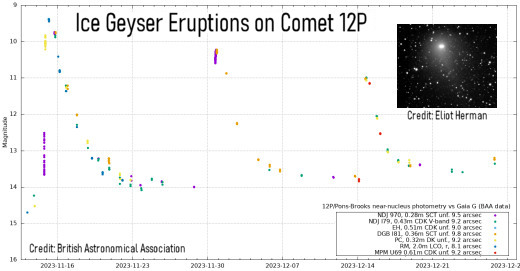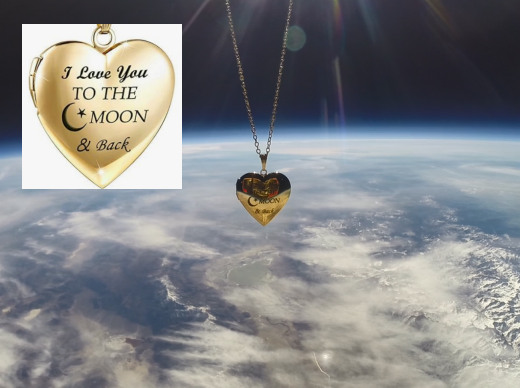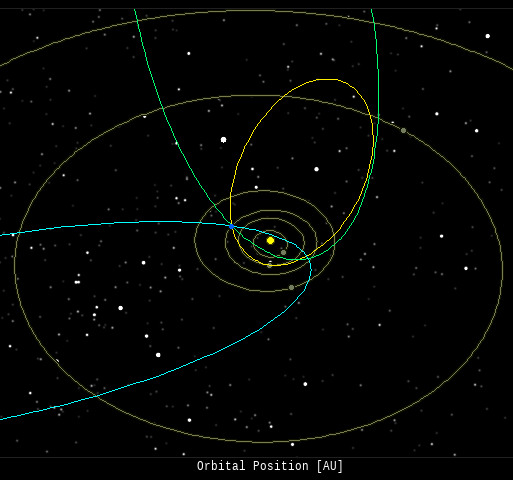This is an AI Free Zone! Text created by ChatGPT and other Large Language Models is spreading rapidly across the Internet. It's well-written, artificial, frequently inaccurate. If you find a mistake on Spaceweather.com, rest assured it was made by a real human being. | | |
X-CLASS SOLAR FLARE: Earth-orbiting satellites have just detected a strong X1.8-class solar flare (Feb. 21 @ 2307 UT). The source is giant sunspot AR3590. Extreme ultraviolet radiation from the flare caused a shortwave radio blackout over the western USA and Pacific Ocean. Stay tuned for information about a possible Earth-directed CME. Solar flare alerts: SMS Text

Above: The extreme UV flash from today's X1.8-class flare. Credit: NASA/SDO
SOLAR ECLIPSE COMET: Anticipation is building for a rare sight during this April's total solar eclipse. In addition to the sun's corona, there's going to be a comet. 12P/Pons-Brooks will be close to the sun during totality, potentially visible to the naked eye inside the Moon's shadow.
Here's what it looks like right now:

Click to view the rest of the comet's tail
Michael Jaeger photographed the comet from his backyard observatory in Austria on Feb. 16th. "The comet's tail is magnificent," he says. "It is currently more than 2.5 degrees long."
At the moment, 12P is invisible to the naked eye; you need a telescope to see it. However, it is approaching the sun for a close encounter in April. Between now and then, forecasters expect the comet's brightness to increase at least 40-fold to magnitude +4.0. That would make it a borderline naked-eye object just in time for the eclipse.
"Border-line naked eye" doesn't sound spectacular, but 12P may have a trick up its sleeve. The comet is famously variable, with surges in brightness that no astronomer can fully predict. 12P is festooned with ice geysers, old-faithful-like vents that spew plumes of gas and dust into space, cloaking the comet in a veil of sunlight-reflecting material. An eruption of one of these geysers during (or even around the same time as) the solar eclipse could catapult it into the realm of magnificent.

The eruptions are not rare. Astronomers recorded at least half-a-dozen in 2023. One of them increased the comet's brightness more than 100-fold (5 magnitudes). These outbursts may become even more frequent as the comet approaches the sun and heat opens more vents.
A tip for eclipse photographers: Take two cameras--one for the sun, and another for Comet 12P. You might be glad you did.
Observing Tip: Venus and Jupiter will be visible, too. Venus will be very bright and shine 15º from the sun even before totality begins, while Jupiter, 30º from the sun, will appear during totality. Comet 12P will be close to Jupiter. [sky map]
Realtime Space Weather Photo Gallery
Free: Spaceweather.com Newsletter
18K GOLD "LOVE YOU TO THE MOON" LOCKET: This is a very special locket. It's heart-shaped, plated with 18K gold, and we will fly it again during this year's total eclipse of the sun. Keep reading...
On Jan. 26, 2024, the students of Earth to Sky Calculus launched this locket to the stratosphere onboard a cosmic ray research balloon. At the apex of the flight, it floated 111,535 feet above the Sierra Nevada mountains of central California:

Buy it now for $149.95, and we'll fly it again--FOR FREE--during the total solar eclipse on April 8, 2024. The students will be launching multiple balloons from the path of totality in Texas. Your pendant will go along for the ride, touching the shadow of the Moon at the edge of space. (Simply type "FLY IT AGAIN" in the comments box at checkout.)
The locket, which opens to hold a personal photo or other small item, comes with a greeting card showing the jewelry in flight and telling the story of its journey to the edge of space.
Far Out Gifts: Earth to Sky Store
All sales support hands-on STEM education
Realtime Aurora Photo Gallery
Free: Spaceweather.com Newsletter
Realtime Comet Photo Gallery
Free: Spaceweather.com Newsletter
Every night, a network of
NASA all-sky cameras scans the skies above the United States for meteoritic fireballs. Automated software maintained by NASA's Meteoroid Environment Office calculates their orbits, velocity, penetration depth in Earth's atmosphere and many other characteristics. Daily results are presented here on Spaceweather.com.
On Feb 20, 2024, the network reported 3 fireballs.
(3 sporadics)

In this diagram of the inner solar system, all of the fireball orbits intersect at a single point--Earth. The orbits are color-coded by velocity, from slow (red) to fast (blue). [Larger image] [movies]
Potentially Hazardous Asteroids (
PHAs) are space rocks larger than approximately 100m that can come closer to Earth than 0.05 AU. None of the known PHAs is on a collision course with our planet, although astronomers are finding
new ones all the time.
On February 21, 2024 there were 2349 potentially hazardous asteroids.
 |
Recent & Upcoming Earth-asteroid encounters: | Asteroid | Date(UT) | Miss Distance | Velocity (km/s) | Diameter (m) |
| 2024 CP5 | 2024-Feb-16 | 16.7 LD | 7.8 | 22 |
| 2024 DE | 2024-Feb-16 | 5.1 LD | 6.2 | 10 |
| 2024 CK6 | 2024-Feb-16 | 11.2 LD | 8.2 | 17 |
| 2024 CP4 | 2024-Feb-16 | 5.7 LD | 11.6 | 30 |
| 2024 AO | 2024-Feb-16 | 9.3 LD | 7.3 | 51 |
| 2024 DV | 2024-Feb-16 | 3.4 LD | 5.7 | 20 |
| 2024 CT6 | 2024-Feb-16 | 0.9 LD | 20.9 | 5 |
| 2024 CA2 | 2024-Feb-16 | 11.8 LD | 10.7 | 48 |
| 2024 CF7 | 2024-Feb-17 | 0.3 LD | 10.6 | 5 |
| 2024 DZ | 2024-Feb-17 | 4.8 LD | 7.6 | 7 |
| 2024 CR5 | 2024-Feb-17 | 17.2 LD | 14.1 | 28 |
| 2024 CS6 | 2024-Feb-17 | 7.5 LD | 6.7 | 21 |
| 2024 CS7 | 2024-Feb-17 | 8.2 LD | 12.8 | 34 |
| 2024 CA8 | 2024-Feb-18 | 7.6 LD | 26.1 | 49 |
| 2024 BC8 | 2024-Feb-18 | 6.2 LD | 10.5 | 30 |
| 2024 DY | 2024-Feb-18 | 0.4 LD | 11.8 | 5 |
| 2024 CH2 | 2024-Feb-18 | 5.7 LD | 9.6 | 22 |
| 2024 CJ6 | 2024-Feb-19 | 4.6 LD | 15.4 | 18 |
| 2024 CV8 | 2024-Feb-19 | 1.2 LD | 17.1 | 20 |
| 2024 DC | 2024-Feb-19 | 12.5 LD | 9.3 | 16 |
| 2024 DL1 | 2024-Feb-20 | 6.5 LD | 10.1 | 13 |
| 2024 CK5 | 2024-Feb-20 | 7.3 LD | 9.5 | 11 |
| 2024 DM1 | 2024-Feb-21 | 8.7 LD | 7.5 | 14 |
| 2024 CL5 | 2024-Feb-21 | 4.8 LD | 14 | 23 |
| 2024 DW | 2024-Feb-22 | 0.6 LD | 17.9 | 14 |
| 2024 CE8 | 2024-Feb-22 | 10.6 LD | 18.8 | 29 |
| 2024 DX | 2024-Feb-22 | 2 LD | 10.4 | 12 |
| 2024 DJ1 | 2024-Feb-22 | 12.5 LD | 13.5 | 34 |
| 2024 BY15 | 2024-Feb-23 | 12 LD | 1.6 | 16 |
| 2024 CL3 | 2024-Feb-23 | 9.3 LD | 4.2 | 19 |
| 2024 CT7 | 2024-Feb-27 | 6.2 LD | 7.7 | 17 |
| 2024 CC7 | 2024-Feb-28 | 15.4 LD | 6 | 19 |
| 2024 CE7 | 2024-Feb-28 | 13.6 LD | 19.3 | 39 |
| 2024 DL | 2024-Feb-29 | 4.6 LD | 6.7 | 24 |
| 2024 CA7 | 2024-Feb-29 | 14.9 LD | 32.5 | 113 |
| 2019 DA1 | 2024-Mar-03 | 14.6 LD | 13.4 | 23 |
| 2024 CW6 | 2024-Mar-04 | 10 LD | 2.5 | 10 |
| 2024 CK8 | 2024-Mar-04 | 6.9 LD | 4.8 | 31 |
| 2024 DA1 | 2024-Mar-11 | 9.4 LD | 9.9 | 49 |
| 2015 FM34 | 2024-Mar-12 | 19.4 LD | 11.1 | 113 |
| 2020 FU | 2024-Mar-15 | 14.9 LD | 15.5 | 19 |
| 2024 CJ8 | 2024-Mar-16 | 17.3 LD | 12.1 | 81 |
| 2020 FD | 2024-Mar-18 | 4.5 LD | 15.1 | 10 |
| 2024 BD7 | 2024-Mar-19 | 18.8 LD | 10.1 | 140 |
| 2019 CJ | 2024-Mar-24 | 12.4 LD | 4.4 | 28 |
| 2021 CF6 | 2024-Mar-25 | 14.6 LD | 8.3 | 62 |
| 2023 RO49 | 2024-Mar-29 | 14.1 LD | 4.3 | 45 |
| 2015 MB54 | 2024-Mar-30 | 11.7 LD | 3.8 | 54 |
| 2024 DQ | 2024-Mar-30 | 6.4 LD | 2.9 | 41 |
| 2018 CC14 | 2024-Apr-03 | 19.6 LD | 8.9 | 115 |
| 2023 GC2 | 2024-Apr-04 | 8.7 LD | 5.7 | 12 |
| 2005 FG | 2024-Apr-08 | 18.4 LD | 5.5 | 57 |
| 2020 BP13 | 2024-Apr-09 | 15.2 LD | 6.8 | 209 |
| 2021 RJ19 | 2024-Apr-12 | 19.6 LD | 11.4 | 25 |
| 2021 GQ5 | 2024-Apr-13 | 8.8 LD | 7.5 | 7 |
| 2023 FN13 | 2024-Apr-14 | 3.3 LD | 4.9 | 13 |
| 2022 UO1 | 2024-Apr-14 | 16.7 LD | 14 | 33 |
| 517681 | 2024-Apr-15 | 18.4 LD | 14.2 | 589 |
| 439437 | 2024-Apr-15 | 8.5 LD | 16.5 | 609 |
| 2023 HU3 | 2024-Apr-18 | 15.9 LD | 19.1 | 35 |
| 2021 JW2 | 2024-Apr-19 | 1.6 LD | 5.1 | 11 |
| 2017 SA20 | 2024-Apr-19 | 3.8 LD | 6.2 | 8 |
Notes: LD means "Lunar Distance." 1 LD = 384,401 km, the distance between Earth and the Moon. 1 LD also equals 0.00256 AU. | | Cosmic Rays in the Atmosphere |
SPACE WEATHER BALLOON DATA: Almost once a week, Spaceweather.com and the students of Earth to Sky Calculus fly space weather balloons to the stratosphere over California. These balloons are equipped with sensors that detect secondary cosmic rays, a form of radiation from space that can penetrate all the way down to Earth's surface. Our monitoring program has been underway without interruption for 7 years, resulting in a unique dataset of in situ atmospheric measurements.
Latest results (July 2022): Atmospheric radiation is decreasing in 2022. Our latest measurements in July 2022 registered a 6-year low:

What's going on? Ironically, the radiation drop is caused by increasing solar activity. Solar Cycle 25 has roared to life faster than forecasters expected. The sun's strengthening and increasingly tangled magnetic field repels cosmic rays from deep space. In addition, solar coronal mass ejections (CMEs) sweep aside cosmic rays, causing sharp reductions called "Forbush Decreases." The two effects blend together to bring daily radiation levels down.
.Who cares? Cosmic rays are a surprisingly "down to Earth" form of space weather. They can alter the chemistry of the atmosphere, trigger lightning, and penetrate commercial airplanes. According to a study from the Harvard T.H. Chan school of public health, crews of aircraft have higher rates of cancer than the general population. The researchers listed cosmic rays, irregular sleep habits, and chemical contaminants as leading risk factors. A number of controversial studies (#1, #2, #3, #4) go even further, linking cosmic rays with cardiac arrhythmias and sudden cardiac death.
Technical notes: The radiation sensors onboard our helium balloons detect X-rays and gamma-rays in the energy range 10 keV to 20 MeV. These energies span the range of medical X-ray machines and airport security scanners.
Data points in the graph labeled "Stratospheric Radiation" correspond to the peak of the Regener-Pfotzer maximum, which lies about 67,000 feet above central California. When cosmic rays crash into Earth's atmosphere, they produce a spray of secondary particles that is most intense at the entrance to the stratosphere. Physicists Eric Regener and Georg Pfotzer discovered the maximum using balloons in the 1930s and it is what we are measuring today.
| | The official U.S. government space weather bureau |
| | The first place to look for information about sundogs, pillars, rainbows and related phenomena. |
| | Researchers call it a "Hubble for the sun." SDO is the most advanced solar observatory ever. |
| | 3D views of the sun from NASA's Solar and Terrestrial Relations Observatory |
| | Realtime and archival images of the Sun from SOHO. |
| | information about sunspots based on the latest NOAA/USAF Active Region Summary |
| | current counts of failed and deployed Starlink satellites from Jonathan's Space Page |
| | Authoritative predictions of space junk and satellite re-entries |
| | from the NOAA Space Environment Center |
| | fun to read, but should be taken with a grain of salt! Forecasts looking ahead more than a few days are often wrong. |
| | from the NOAA Space Environment Center |
| | the underlying science of space weather |
 | When looking for casinos to play online when the weather is bad, you can try the SkyCity Online Casino if you are located in New Zealand. If you are not from NZ you can try the Swedish page Svenska casino online to find suitable games, check out svenskacasinoonline.net. Always check your local laws before playing with real money.. |
 | BestCSGOGambling is the best site for everything related to CSGO gambling on the web |
| | These links help Spaceweather.com stay online. Thank you to our supporters! |
| | | | | | |

